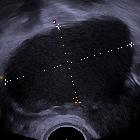mesonephroid carcinoma of the ovary
Clear cell carcinoma of the ovary is a type of malignant ovarian epithelial tumor.
Epidemiology
They represent ~2-5% of all ovarian carcinomas and ~3.7%-12% of epithelial ovarian neoplasms. The mean age at presentation is ~10 years younger than for other ovarian epithelial tumors (peaks ~55 age of age )
Pathology
Clear cell tumors are thought to arise from the embryonic mesonephros. Macroscopically comprise of a large unilocular cystic mass with protruding solid nodules. These are histologically very similar to clear cell carcinomas of the endometrium, cervix, or vagina.
Associations
Clear cell carcinoma may develop in patients with endometriosis (~25% of cases) who develop ovarian cancer and this may be to an ARID1A gene mutation .
Radiographic features
Common imaging findings in clear cell carcinoma include a unilocular or large cyst with one or more solid nodular protrusions into the cavity.
CT
Typically seen as a large unilocular, mainly cystic, smooth marginated mass with lumen protruding solid portion and high-attenuated cystic portion .
MRI
Often seen as a cystic ovarian mass with the margin being generally smooth. Solid protrusions are often both round and few in number.
Reported signal characteristics include
- T1: can vary from low to very high (often dependent on hemorrhagic component(s), not a specific feature)
Staging
Staging is the same as general ovarian cancer staging
Treatment and prognosis
They are almost always malignant although the majority (75%) of clear cell carcinomas present as stage I disease whose prognosis appears to be better than that of other ovarian cancers of comparable stage. Overall response to chemotherapy in advanced stages is considered poor .
See also
Siehe auch:
und weiter:

 Assoziationen und Differentialdiagnosen zu clear cell ovarian carcinoma:
Assoziationen und Differentialdiagnosen zu clear cell ovarian carcinoma:

